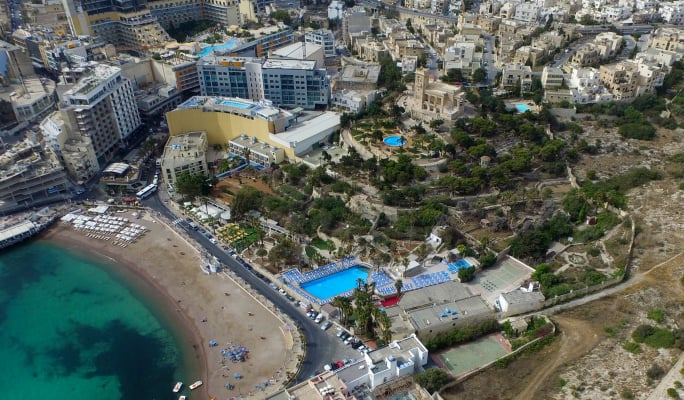Shifting goalposts at Villa Rosa: From policy, to project-driven
James Debono tells the story of shifting planning goalposts in Paceville’s last green oasis, dominated by a solitary art nouveau mansion and its gardens, which now risks being overshadowed by two massive towers

Despite the sweeping changes transforming Malta’s entertainment hub since the mid-1980s, time seemed to stand still for Villa Rosa and its surroundings along St George’s Bay.
The Art Nouveau mansion, designed by architect Andrea Vassallo in the 1920s, remained largely untouched, its gardens and the bay below offering a sense of serenity amid the ongoing urban development. St George’s Barracks, which predated it on the eastern side of the beach, and later, the Corinthia hotels, were the only structures to rival its presence.
It all started to change with the local plans approved in 2006, which split the Villa Rosa grounds into nine different zones, four of which were earmarked for a mix of tourism, residential, and commercial development, with the highest height limitation of seven floors applying to the area next to the Bay Street mall, on St George’s Road. Development in this zone was to be terraced and stepped down to two floors in the area adjacent to St George’s Bay and the Villa Rosa gardens.
Another zone of intensive development, where commercial development was limited to four floors, was proposed in the area behind Andrew’s Bar on the other side of the bay, where a car park was also proposed.
While the “upper gardens” around the villa were to be protected, 15 bungalows could be built on another part of the gardens near the protected Wied Ħarq Ħamiem.
The local plan also decreed that any development carried out in surrounding areas should not compromise the setting of the villa, valley, and the bay.
However, it was these changes that appreciated the value of the site, which was bound to increase interest in the area.
Camilleri enters the scene
In 2009, the Vic Bon, later Garnet Investments company owned by Anton Camilleri ‘tal-Franċiż’, purchased Dolphin House and the Villa Rosa holiday complex from the Cardiff-based company called C.H. Bailey plc for €32 million and €2.6 million, respectively.
Back then, the soft-spoken developer and quarry owner told MaltaToday that the company still had to “sit around the table to decide what to do” with the land they had purchased. He promised that any development on the site “will make the area more beautiful than it is today.”
However, the Camilleris’ investment was not a leap in the dark. The local plan for the area had already paved the way for lucrative developments on the northern and southern flanks of the site.
This led to the presentation of a formal planning application in 2014 and approved in 2018, for development foreseen in the local plan together with a four-storey, 56-room hotel at Cresta Quay on the eastern side of the bay. It included Moynihan House, which lies outside the Villa Rosa grounds, designated as an ‘Entertainment Priority Area’ – a generic category covering most of Paceville for a mix of dwellings, shops, restaurants, hostels and hotels.
The valley watercourse area was also earmarked for 15 two-storey villas with private pools. The historical Moynihan and adjacent Dolphin properties were to be demolished and redeveloped into a car park, restaurants, offices, and a language school, despite the fact that an environmental impact statement unambiguously concluded that Moynihan House deserved Grade 2 protection.
High rise plans frustrated by masterplan
While plodding on with this application, Camilleri was toying with the idea of a high-rise development rising in the central area of the beach right in front of Villa Rosa.
In 2016, MaltaToday revealed that Camilleri had presented plans for a 36-storey high-rise designed by the world-renowned Zaha Hadid architectural firm in a development stretching all the way from Cresta Quay to Moynihan House in a vessel-like creation.
Yet subsequently, the Villa Rosa site was not earmarked for high-rise development in the Paceville masterplan drafted by international consultants Mott Macdonald. Instead, the masterplan proposed the erection of a 30-storey high-rise on the Cresta Quay site.
The logic for locating the tower on this site was to minimise the overshadowing of the beach and retain Villa Rosa as the prominent landmark overlooking the beach. Addressing a parliamentary committee discussing the masterplan, Anton Camilleri insisted that this was not his idea. “I did not write the plan myself. It’s not what I had originally submitted, and we still have to make studies on the viability of what is proposed in the master plan.”
However, the masterplan was later scrapped, following revelations that the international consultants had a conflict of interest due to their consulting job for Mercury House developer Joseph Portelli.
In the absence of the masterplan, the Planning Authority proceeded with the approval of individual high-rises proposed by different developers, including the already constructed Mercury Tower, the approved DB project, and another high-rise proposed by Paul Xuereb’s PX Lettings, instead of the villas on the road leading to the Eden Cinema.
Camilleri’s turn is next
Anton Camilleri bided his time and applied to renew the permit issued in 2018 while working on new plans, which first came to light in a Project Description Statement (PDS) published in January 2022.
The proposed changes, which included two towers of 35 and 27 floors, increased the gross floor area of the project from 141,000sq.m as approved in 2018 to a staggering 237,000sq.m.
Significantly, the PDS invoked the Hotel Heights Adjustment Policy approved in 2014, which allows all hotels within the development zone to rise two storeys above local plan limits and all standalone hotels to rise even higher, provided they included an adjacent public square.
In fact, the PDS highlighted the creation of 20,086sq.m of public open space, including a piazza, adding that “in view of such an approach, the High Limitation Adjustment policy for hotels is being applied in view of the development of the open spaces and also circulation space requirements.”
In an indication that the project was viewed favourably by the powers that be, on the eve of the 2022 election, the Lands Department issued a tender for the sale of a public alley in St Julian’s, set to become a 5.5m tunnel to service access to his proposed development in Villa Rosa.
Camilleri was the sole bidder, and the land was sold for just €134,000.
The shift to serviced apartments
Further changes were then made to the project in an Environmental Impact Assessment presented later in 2022.
The project was now set to host 789 serviced apartments, 247 hotel rooms, and a total of 16,000 sq.m of office space.
“This is not more of the same project. We are aiming at excellence and quality, setting trends for the entire country and the Mediterranean,” Camilleri’s son Adelbert told MaltaToday in March 2023.
Crucially, he emphasised the shift to short-term rental apartments with five-star hotel amenities. “They will generate less traffic than residential apartments, mostly catering for short stays without a need for a car.”
However, the inclusion of “serviced apartments” connected to the hotel development also enabled Camilleri to build higher, thanks to the hotel heights policy, especially if these apartments are counted as being ancillary to the hotel.
Camilleri has now attempted to greenwash the project, emphasizing the removal of the 15 villas already approved along the valley and the creation of an 11,000 sq.m ‘Pjazza Tritoni-size’ open square along the beach.
But the EIA studies show the project comes at an environmental cost with the increased shadowing on Pembroke’s residential areas and the beach, particularly in the winter months. Moreover, in summer, the shadows of the northern cluster will appear on the beach at 4pm, covering “all the sandy beach” by 6pm.
In what appears to be a clear breach of the local plan, the project will compromise the setting of the historical villa. A visual impact assessment shows that the high-rise in some cases completely obscures views of the historical villa. A report assessing the impact on cultural heritage, also included in the EIA, concludes that “it is very clear that with the proposed development, the present skyline, with Villa Rosa perched on a hill and dominating the bay, will be lost forever.”
The Superintendence for Cultural Heritage called for a lowering of the project’s height to minimise the visual impact on the cultural landscape of St George’s Bay, particularly Villa Rosa and its gardens.
But while visuals of the project were largely met by public derision, it was the current local plan which stood as the greatest obstacle for the project.
Government steps in to change goalposts
It is therefore no surprise that the declared “objectives” of changes to the local plan policies regulating the development on the site, suddenly align with the project as proposed by Camilleri, in what appears to be a textbook case of project-driven policy.
In this case, the local plan changes which envisage an increase in the amount of public open space over that envisaged in the current local plan, are already in line with Camilleri’s plans for a massive public square.
But this is also the key to align the project to the policy regulating hotel heights.
Crucially, the changes “establish the allowable building heights for each sub-zone, including through the application of the Height Limitation Adjustment Policy for Hotels of 2014.”
It is this change that will give Camilleri the certainty that he can develop a high-rise in the area, despite the very clear restrictions on building heights found in the current local plan. The changes also add the area previously occupied by Moynihan House, on which the PA has already approved a six-storey office block, to the Villa Rosa grounds.
The published objectives vaguely state that development on this site should “not create unacceptable environmental impacts on the surrounding environmentally sensitive areas, buildings, features, and recreational spaces.” However, it remains to be seen how this generic commitment aligns with the concerns expressed by the government’s own cultural heritage watchdog regarding the towers obscuring the historical villa.
Yet the government may well try to appease public opinion, by for example removing the zone allocated for villas, which no longer feature in Camilleri’s project, and possibly reduce the height of the development, which as proposed now will be the highest building in the island – eight floors higher than Townsquare and two floors higher than Mercury Tower and the PX building.
The scale of the project proposed in 2022 surely gives the developers latitude to make changes to their project, following the example set by other developers like the DB Group who reduced the originally proposed height of the tower from 38 floors to two 17-storey towers, and Townsquare in Sliema which was reduced from 38 floors to 28 floors.
In fact Camilleri has already hinted in a press statement this week in which he committed “to reduce the height from the current proposed application and establish the building heights to ensure no future applications for additional floors.”
But interestingly, no commitment was given to reducing the floor space, that is the total amount of developable space contemplated in the application.
Changing the goalposts to thwart appeals?
Still why should the government intervene to change the goalposts for Camilleri’s development?
One possible reason is that Labour Prime Minister Robert Abela is so keen on having a flagship project happening on his watch that he wants to thwart any appeal by civil society against it. For while the PA will probably approve the project by invoking the hotel heights policy, arguing that these rules now supersede the local plan’s restrictions, environmental NGOs may well appeal this decision, insisting that the local plan is very specific in determining the Villa Rosa development heights.
Moreover, it is clear that the intention of the local plan was that of protecting views of Villa Rosa and the surrounding gardens.
This argument may well prevail in the courts, which, unlike the Planning Authority, are independent of the government, as demonstrated by a number of decisions revoking permits issued by the Planning Authority which send shivers down the spine of developers.
VILLA ROSA TIMELINE
August 2006: The local plan zones parts of the Villa Rosa grounds for tourism and residential development, limiting development to a maximum of seven floors.
November 2009: Anton Camilleri buys Villa Rosa and Dolphin House from a Cardiff-based investment company for €32 million and €2.6 million, respectively.
October 2013: An application is presented envisioning a hotel on the Cresta Quay site, the demolition of Moynihan and Dolphin House, and the erection of a mix of commercial and residential developments rising to a maximum of six floors.
May 2016: MaltaToday reveals that Camilleri has plans for a 36-storey tower designed by the office of world-renowned architect Zaha Hadid overlooking St George’s Bay.
November 2016: The Paceville masterplan excludes the Villa Rosa site from high-rise development while proposing three high-rise buildings on the Cresta Quay site along the coastline, which is also owned by Camilleri.
August 2018: The Paceville Masterplan is officially “put on hold” after the revelation that consultants were also engaged in Joseph Portelli’s Mercury House project.
February 2018: Low-rise development on Villa Rosa grounds, Moynihan House and Cresta Quay is approved, paving the way for the demolition of Moynihan House, despite the EIA recommending its inclusion in the list of scheduled buildings.
January 2022: Anton Camilleri presents a Project Development Statement to increase floor space from the 141,000 sq.m approved in 2018 to 237,000 sq.m by opting for a high-rise development. The Height Limitation Adjustment policy for hotels, which permits hotels to rise above local plan limits, is invoked.
April 2022: During the election campaign, the Lands Department awards a tender transferring ownership of a public alley in the Villa Rosa site to Camilleri, allowing him to roof it over for the price of €134,000.
August 2022: A planning application, including the high-rise development mentioned in the PDS, is presented.
March 2023: An EIA is presented for the construction of 789 serviced apartments, 247 hotel rooms, and a total of 16,000sq.m of office space housed in two towers: one of 35 floors and another of 27, as a study warns of negative visual impacts, including on the setting of the villa and a shadowing effect on the public beach.
October 2024: The government orders the Planning Authority to commence public consultation on changes that would allow Camilleri to develop the site based on the Height Limitation Adjustment policy for hotels, which permits standalone hotels to rise above local plan limits.


































